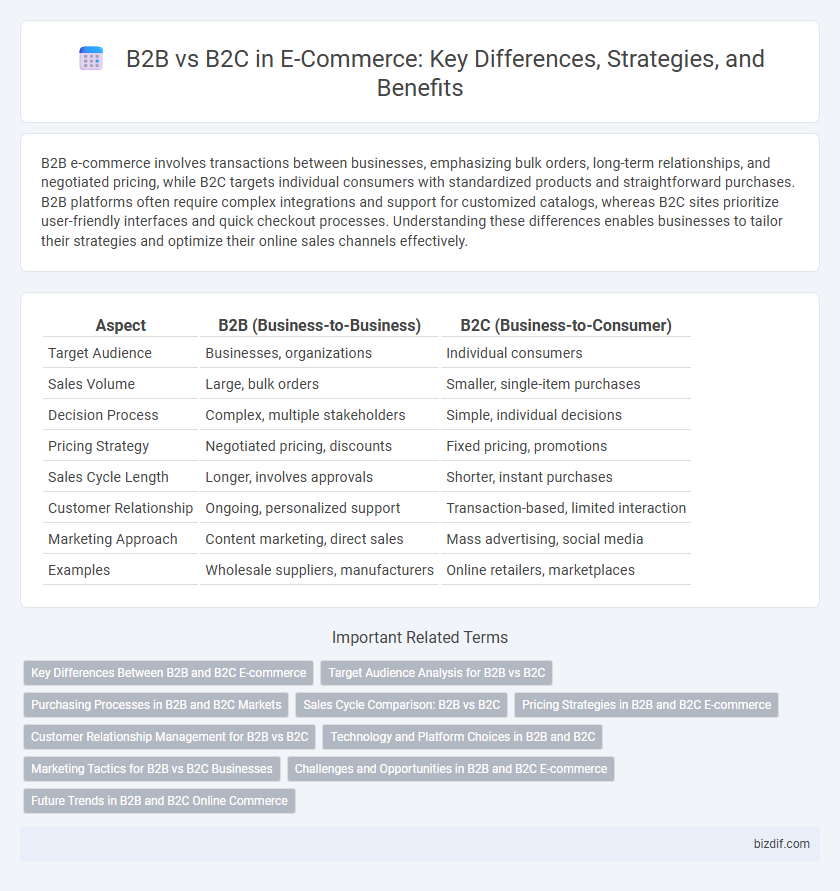B2B e-commerce involves transactions between businesses, emphasizing bulk orders, long-term relationships, and negotiated pricing, while B2C targets individual consumers with standardized products and straightforward purchases. B2B platforms often require complex integrations and support for customized catalogs, whereas B2C sites prioritize user-friendly interfaces and quick checkout processes. Understanding these differences enables businesses to tailor their strategies and optimize their online sales channels effectively.
Table of Comparison
| Aspect | B2B (Business-to-Business) | B2C (Business-to-Consumer) |
|---|---|---|
| Target Audience | Businesses, organizations | Individual consumers |
| Sales Volume | Large, bulk orders | Smaller, single-item purchases |
| Decision Process | Complex, multiple stakeholders | Simple, individual decisions |
| Pricing Strategy | Negotiated pricing, discounts | Fixed pricing, promotions |
| Sales Cycle Length | Longer, involves approvals | Shorter, instant purchases |
| Customer Relationship | Ongoing, personalized support | Transaction-based, limited interaction |
| Marketing Approach | Content marketing, direct sales | Mass advertising, social media |
| Examples | Wholesale suppliers, manufacturers | Online retailers, marketplaces |
Key Differences Between B2B and B2C E-commerce
B2B e-commerce involves transactions between businesses, emphasizing bulk orders, longer sales cycles, and personalized pricing, whereas B2C focuses on individual consumers with shorter decision-making processes and standardized pricing. The purchasing behavior in B2B is driven by logic and ROI, while B2C is influenced by emotion and brand experience. Payment methods and order volumes also differ significantly, with B2B favoring invoicing and large quantities, and B2C typically relying on immediate payment and smaller orders.
Target Audience Analysis for B2B vs B2C
Target audience analysis in B2B e-commerce prioritizes industry-specific needs, decision-making hierarchies, and long sales cycles, targeting businesses with tailored solutions. In contrast, B2C focuses on individual consumer behavior, preferences, and emotional triggers, emphasizing personalized experiences and quick purchasing decisions. Understanding these distinct audience characteristics enables e-commerce platforms to optimize marketing strategies and product offerings effectively.
Purchasing Processes in B2B and B2C Markets
B2B purchasing processes are typically complex, involving multiple decision-makers, longer negotiation periods, and customized contracts tailored to specific business needs. In contrast, B2C purchasing is streamlined, driven by individual consumer preferences, faster decision-making, and straightforward transactions often supported by automated checkout systems. Advanced technologies like AI-driven recommendation engines and integrated procurement platforms enhance efficiency in both B2B and B2C markets.
Sales Cycle Comparison: B2B vs B2C
The B2B sales cycle typically involves a longer duration, averaging 3 to 9 months due to complex decision-making processes, multiple stakeholders, and customized solutions. In contrast, B2C sales cycles are shorter, often ranging from seconds to a few days, driven by impulse buying and straightforward product offerings. Understanding these differences is crucial for tailoring marketing strategies and sales enablement tools specific to each model.
Pricing Strategies in B2B and B2C E-commerce
B2B e-commerce pricing strategies often involve volume discounts, negotiated contracts, and tiered pricing models to accommodate bulk purchases and long-term partnerships. In contrast, B2C pricing focuses on dynamic pricing, promotional offers, and psychological pricing tactics to attract individual consumers and drive impulse buying. Understanding the distinct purchasing behaviors and sales cycles in B2B and B2C markets is crucial for optimizing pricing strategies and maximizing revenue.
Customer Relationship Management for B2B vs B2C
Customer Relationship Management (CRM) in B2B e-commerce centers on developing long-term partnerships and managing complex sales cycles involving multiple stakeholders, requiring personalized communication and detailed account management. In contrast, B2C CRM emphasizes rapid, individualized customer interactions driven by high transaction volumes, leveraging automation and data analytics to enhance customer loyalty and improve user experience. Effective CRM strategies in B2B focus on lead nurturing and after-sales support, while B2C prioritizes customer segmentation and real-time engagement through digital channels.
Technology and Platform Choices in B2B and B2C
B2B e-commerce platforms prioritize advanced integrations with ERP and CRM systems to support complex procurement workflows and large transaction volumes, while B2C platforms focus on user-friendly interfaces and scalable cloud solutions to enhance customer experience and manage high traffic. Technologies like API-driven architectures and customizable catalogs are critical in B2B to accommodate personalized pricing and bulk orders, contrasting with B2C's emphasis on SEO optimization, mobile responsiveness, and streamlined checkout processes. Choosing the right platform depends on business goals, with B2B demanding robust security features and multi-user access control, while B2C investments often center on marketing automation and customer engagement tools.
Marketing Tactics for B2B vs B2C Businesses
B2B marketing tactics prioritize relationship-building strategies such as targeted email campaigns, LinkedIn outreach, and content marketing focused on industry expertise to appeal to decision-makers. B2C marketing emphasizes emotional engagement through social media advertising, influencer partnerships, and personalized promotions to drive quick consumer purchases. Data-driven segmentation and customer journey mapping are essential for optimizing both B2B and B2C marketing efforts.
Challenges and Opportunities in B2B and B2C E-commerce
B2B e-commerce faces challenges such as complex purchasing processes, longer sales cycles, and the need for customized pricing and bulk orders, but offers opportunities in building long-term client relationships and large-volume transactions. B2C e-commerce struggles with high competition, customer retention, and demand for seamless, fast shopping experiences while benefiting from a vast consumer base and opportunities for personalized marketing and brand loyalty. Leveraging data analytics and automation can optimize both B2B and B2C operations, addressing their challenges and amplifying growth potential.
Future Trends in B2B and B2C Online Commerce
Future trends in B2B online commerce emphasize AI-driven personalization, streamlined procurement processes, and enhanced integration with supply chain management systems to optimize buyer-seller interactions. B2C e-commerce continues to evolve with augmented reality for immersive shopping experiences, voice commerce growth, and hyper-personalized marketing powered by advanced data analytics. Both sectors increasingly adopt omnichannel strategies and blockchain technology to improve transparency, security, and customer trust in digital transactions.
B2B vs B2C Infographic

 bizdif.com
bizdif.com